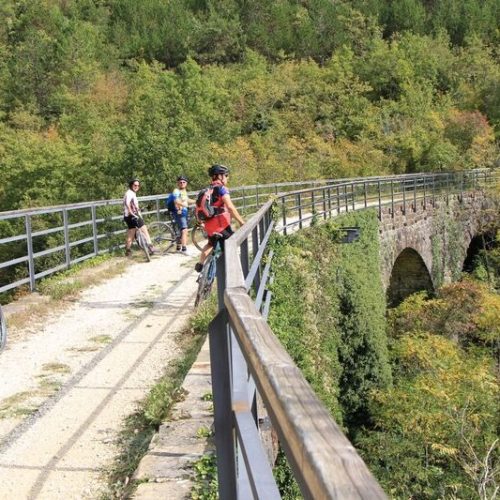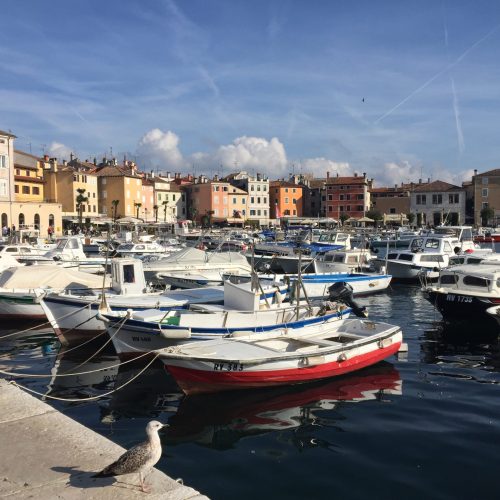Mit dem Fahrrad von Triest nach Pula


Mit dem Fahrrad von Triest nach Pula
AUSGEWÄHLTE MERKMALE:
- 7 Tage in Istrien (6 Nächte); kann angepasst
- Übernachtung in Hotels/Pension
- 1 Mittag im Preis inbegriffen
- 3 Abendessen (optional)
- Getränke und Energieriegel sind im Preis der Führung inbegriffen.
- 1 Weinprobe
- Besuch einiger der bekanntesten Reiseziele in Istrien: Buje, Grožnjan, Motovun, Poreč, Rovinj, Fažana, Pula, Kap Kamenjak

Mit dem Fahrrad von Triest nach Pula
Trieste/ Muggia, Izola, Portoroz, Koper, Buje, Groznjan, Motovun, Porec, Rovinj, Pula
Dauer: 6 Nächte
Schwierigkeitsgrad: mittel
Ausflugsart: eigenständige Radtour
Termine:
auf Anfrage
Start: – Transfer Triest – Muggia
Der Preis pro Person beinhaltet:
Vegane / vegetarische Optionen verfügbar
Zusätzliches Angebot:
- 6 Tage Fahrradverleih
MTB / Trekking (inklusive Vorhängeschloss, Werkzeug, Helm): 140 EUR
E-MTB (inklusive Vorhängeschloss, Werkzeug, Helm): 240 EUR
- Übernachtung in Triest
- Die Reiseversicherung ist nicht im Preis inbegriffen. Sie können dies mit der gewünschten Versicherungsgesellschaft vereinbaren.
Optionen
- einen örtlichen Reiseführer während aller 6 Tage in englischer, deutsche Sprache
- Extra Nächte in Motovun, Poreč, Rovinj oder Pula (auf Anfrage)
Note: This itinerary is the copyright of Maremonti Istra Ltd.
1. Tag
Triest – Muggia entlang Parenzana bis Buje 55 km /34 miles
Transfer vom Hotel in Triest zum Ausgangspunkt der Tour – Muggia. Nachdem wir die Ausrüstung angepasst haben, machten wir uns auf den Weg entlang Parenzana in Richtung Kroatien. Parenzana war einst eine bedeutende Eisenbahnverbindung zwischen Triest und Poreč. Vor einigen Jahren wurde die Bahnstrecke in einen Fahrrad-Fußgängerweg mit restaurierten alten Brücken und Tunneln umgewandelt. Wir fahren über die slowenische Grenze nach Kroatien und folgen dem Küstenradweg durch die mittelalterlichen Stadt Koper, Izola und die benachbarten Wellnessstadt Portorož. Unterkunft in Buje. Mittagessen und freier Nachmittag für individuelle Programme und Aktivitäten. Wir empfehlen Ihnen, sich mit der reichen Geschichte der Altstadt vertraut zu machen. Übernachtung in Buje.
2. Tag
Parenzana – von Buje nach Motovun (pause Grožnjan und Livade) 40 km/25 miles
Nach dem Frühstück fahren wir nach Grožnjan, der sogenannten „Stadt der Künstler“. Wir machen eine Pause für Erfrischungen und Besichtigungen. Danach fahren wir weiter nach Livade, der Heimat der istrischen Trüffel. Optionale Trüffelverkostung. Wir fahren weiter in Richtung Motovun, einer mittelalterlichen Stadt auf einem Hügel über den Weinbergen. Mittagspause in einer örtlichen Taverne. Eine ideale Gelegenheit, um den berühmten istrischen Aufschnitt (Schinken, Wurst, Käse) und hausgemachte Pasta mit Trüffeln zu probieren. In Freizeit Wir empfehlen einen Spaziergang durch die einzigartige mittelalterliche Stadt. Übernachtung in Motovun
3. Tag
von Motovun bis Poreč 45 km /28 miles
Nach dem Frühstück fahren wir weiter durch Parenzana nach Poreč. Ankunft in Poreč am Nachmittag, Unterkunft in einem 4* Hotel direkt neben den Stränden von Poreč.
Wir empfehlen einen Spaziergang in der Altstadt von Poreč und einen Besuch der UNESCO-geschützten Euphrasius-Basilika. Abendessen und Übernachtung in Poreč.
4. Tag
Poreč – Rovinj über den Lim-Kanal 50 km /31 miles
Nach dem Frühstück fahren wir weiter entlang der Westküste durch die Blaue und Grüne Lagune mit herrlichem Blick auf das offene Meer und die Inseln des Archipels. Pause und Erfrischung im Hafen von Vrsar. Wir fahren weiter auf einer Schotterstraße über dem Lim-Kanal, der bis zu 11 km landeinwärts reicht. Er ist bekannt für seine steilen Hänge und das türkisblaue Meer. Wir fahren weiter auf schmalen Straßen und Wegen durch Weinberge nach Rovinj, einer der romantischsten Städte an der Adria, geschmückt mit engen Kopfsteinpflasterstraßen, authentischen Häusern und zahlreichen Kunstgalerien, Cafés und Tavernen.
Mittagessen im historischen Teil der Stadt und eine kurze Fahrt zum Hotel. Unterkunft in einem 4* Hotel. Wir empfehlen eine selbstständige Besichtigung am Nachmittag und einen Besuch der Kirche der hl. Euphemia, dessen Glockenturm einen einzigartigen Blick auf das gesamte Rovinj und den Rovinj-Archipel bietet.
Übernachtung in Rovinj.
5. Tag
Rovinj – Pula entlang der Fažane Promenade 45 km /28 miles
Frühstück. Wir fahren weiter auf einer Schotterstraße durch Weinberge und Wälder und in der Nähe eines besonderen ornithologischen Reservats Palud. Unser erstes Ziel ist Fažana, ein kleines Fischerdorf, das auch Ausgangspunkt für den Brijuni-Nationalpark ist. Dank der schönen Natur und reichen Geschichte zieht Fažana das ganze Jahr über viele Touristen an. Während der letzten Etappe erreichen wir Pula, die älteste Stadt der Halbinsel und der ideale Ort, um die Tour abzuschließen. Pula ist eine geschichtsträchtige Stadt mit ihrem Wahrzeichen – dem römischem Amphitheater Arena. Wir fahren durch Pula und lernen die wichtigsten Sehenswürdigkeiten kennen. Unterkunft in einem 4* Hotel und Freizeit bis zum Abendessen. Abends empfehlen wir einen angenehmen Spaziergang am Meer oder einen Besuch des Aquariums in der 130 Jahre alten Verudela-Festung. Übernachtung.
6. Tag
Pula – Kap Kamenjak 35 km /22 miles
Nach dem Frühstück fahren wir zum Kap Kamenjak, dem südlichsten Punkt der istrischen Halbinsel. Kamenjak ist eine kleine Halbinsel mit einer Länge von nur 9,5 km und einer sehr abwechslungsreichen Küste. Wir fahren durch die idyllische Landschaft bis in den Süden der Halbinsel, wo wir uns ausruhen und erfrischen werden.
Danach fahren wir zum örtlichen Weingut, wo uns eine Weinprobe erwartet. Wir haben die Möglichkeit, traditionelle istrische Spezialitäten wie Käse, Schinken und Wurst zu probieren und lokale Spitzenweine zu genießen.
Rückkehr nach Pula. Der Rest des Tages steht zur freien Verfügung.
7. Tag
Pula
Frühstück. Programmende.
Departure point
Pick up in Trieste and transfer from to start point. Cycling start near Muggia.
Payment Methods
The standard payment term is a deposit payment of 30% with credit card (on-line payment via link), Pay Pall or bank transfer.
The remaining balance should be settled 30 days prior the departure date through bank transfer or credit card.
Payment by bank transfer:
Beneficiary: Maremonti Istra d.o.o., Flavijevska 22, 52100 Pula – Croatia
Bank: Raiffeisenbank Austria, Petrinjska 59, Zagreb, Croatia
IBAN: HR2224840081102426002
SWIFT: RZBHHR2X
Conversion Statement
All payments will be effected in currency Euro. When charging your credit card, the same amount is converted into your local currency according to the exchange rate of credit card associations. As a result of this conversion there is a possibility of a slight difference from the original price stated in our web site.
 Deutsch
Deutsch English
English Hrvatski
Hrvatski















